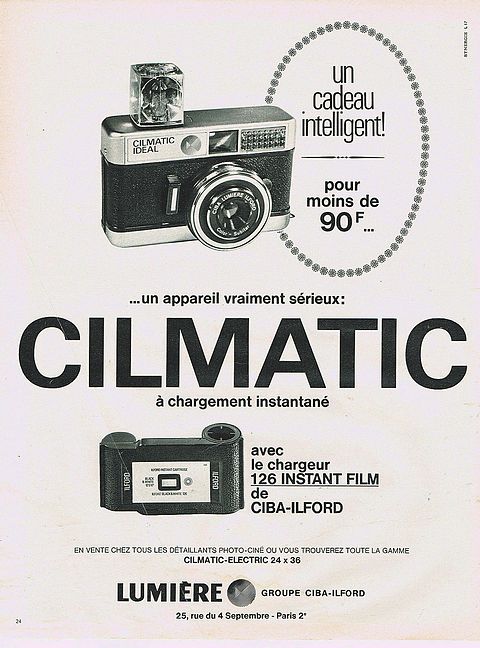| ILFORD Sportina Ilfomatic |
|
|
||
|
|
||
|
The Sportina Ilfomatic uses essentially the same body as the Sportina Rapid range of cameras, but the film it takes is the Kodak Instamatic 126 cartridge, instead of the Agfa Rapid cassette system. It was made by Dacora in West Germany. The range is believed to have first appeared in 1966. The arrival of an Ilford camera taking 126 cartridge films was belated due to Ilford initially favouring the Rapid cassette film system over its rival's 126 cartridge system. There is little doubt that the Rapid system was better, from a purely technical stand-point, but for a simple snap-shot type of camera, as the Ilford range was intended to be, the technical merits of the Rapid system was unlikely to manifest, whereas the majority of snap-shot camera owners would have undoubtedly preferred the total simplicity of 126 cartridge loading. 126 cartridge availability was no doubt wider than Rapid cassettes, which would have been another factor favouring the 126 format. The lens is a 40mm 3-element f3.9 Color-dignar, focusing using the Ilford trade mark symbols of 'faces' for 'head & shoulder' close-ups, 'people' for middle distance and 'places' for far distance. These appear on the upper surface surrounding lens ring, while actual distances appear in a cut-out window below the lens. Focusing is click-stopped at the "faces, people & places" symbols, at the distances 6feet, 12feet and 35feet. A lever-wind advances the film from frame to frame and there is a double-exposure prevention mechanism. Simple weather symbols provide a degree of exposure guidance. Colourful symbols represent bright sun, cloudy bright, cloudy and cloudy dull. A yellow dot on the lens ring immediately adjacent the camera body is aligned with these symbols depending upon the user's judgment. It is believed these settings provide 1/90th second at f11, 1/90th second at f8, 1/90th second at f5.6 and 1/90th second at f4 (though presumably the f4 setting is actually the full f3.9 lens aperture). These exposures would be about right for the 64ASA (ISO) films commonly available in the Kodak 126 cassette fitting during the mid-1960s. The aperture varies by virtue of two thin metal plates with 90° cut-outs, that overlap to form varying size square openings. The behind-lens shutter is also very simple, consisting of just two blades, one hinged to swing left and the other hinged to swing right, when opening. There is a socket on the top plate for flash cubes, fired by a 15volt battery inserted into the camera body from below. If the yellow dot on the weather symbol lens ring is turned past the 'dull' setting, so that its dot aligns with the usual lightning symbol, then the exposure is set at 1/40th second at f4 (presumably f3.9). The flash distance is advised, by a label on the cube eject button on the camera's top plate, to be 4feet to 9feet (1.2m to 2.7m). A flash cube gave 4 individual flash exposures, with the cube turning automatically between each exposure, under the action of the film lever-wind. The Ilfomatic was supplied with a soft black plastic (leather look) pouch case and a wrist strap. The pictures below show further details of the Sportina Ilfomatic. At the base of the page is shown a French Cilmatic, from the same Dacora series. |
